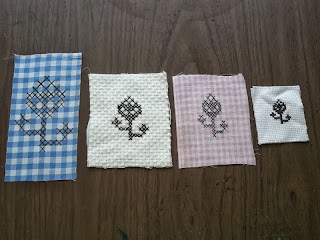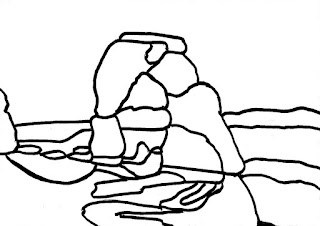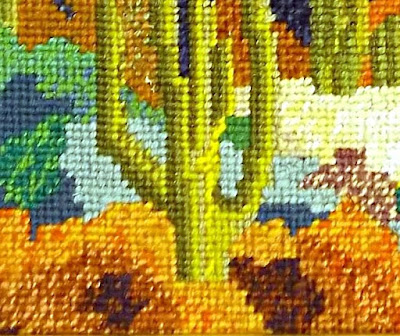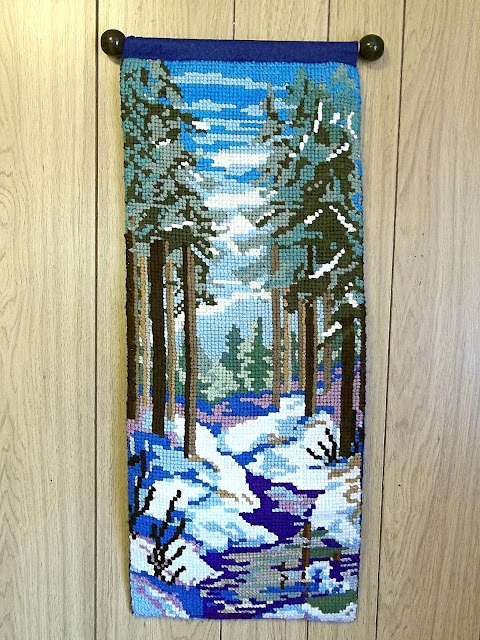 |
| Blackwork Owl on checked gingham |
On February 13th of this year we began the 6th year of this blog. Welcome, viewers from new countries that joined us this past year: Angola, Algeria, Azerbaijan, Belarus, Bosnia & Herzegovina, Brunei, Gabon, Guadeloupe, Iran, Iraq, Lebanon, Macau, Panama, Paraguay, Serbia, Swaziland, Trinidad & Tobago, Tunisia, and Yemen. We have put symbols for each of those countries on our big wall map. We also want to send our sympathy and best wishes to those areas of the world where natural disasters did so much damage during that time.
We are delighted by the response to the Art Forms in Needlework series and plan to add to it each month for the rest of the year. Along with those posts, we will re-visit some techniques from past posts which got the most attention from viewers, like folk embroidery, geometric designs, optical illusions, and needleweaving. The first of these is the subject of the article below, blackwork embroidery. This topic will return later this year as new patterns are developed.
| Various pastel ginghams |
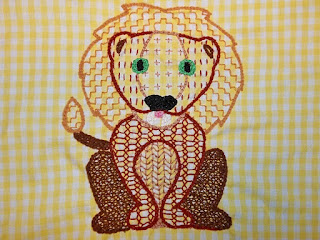 |
| Holbein embroidery lion |
| Chart for Blackwork Owl |
So I started working on new sketches and converting them into blackwork patterns like this one for the owl.
But just a few weeks later, our wonderful friend died suddenly after a shockingly brief illness. We were devastated. I folded the ginghams and put them and the patterns away in a drawer, not really expecting to ever look at them again.
But just a few weeks later, our wonderful friend died suddenly after a shockingly brief illness. We were devastated. I folded the ginghams and put them and the patterns away in a drawer, not really expecting to ever look at them again.
But recently I began to realize that she would have been disappointed that I didn’t go ahead with the project. She would have scolded me for quitting in the middle of it. I got everything out of the drawer and spread it out on my worktable. I made a hot-iron transfer for the outline of the fish (see the directions for making hot-iron transfer on the post for October 6, 2013) and ironed it onto aqua gingham.
I have done many butterfly designs for different kinds of needlework. I looked for one that I could modify for blackwork. I chose this pillow pattern, done in “stained-glass stitchery” (directions on the post for March 8, 2015) on a needlepoint background, and made a very simplified black line design for it. Then I made an iron-on transfer from the black line design. I debated doing a different blackwork design in each section, but decided that would break up the butterfly design too much, so I will do the same blackwork designs on the corresponding parts of both wings, reversing their directions where it is possible to do so.
| Butterfly pillow and line drawing |
I have “converted” the lion from Holbein embroidery and made a pattern for him in blackwork. I had previously made a transfer pattern of his outline to iron on the background for the multicolored design. I considered just “refreshing” that pattern, but decided to do a new one instead. I have had some success in re-using iron-on patterns, but they are seldom as sharply drawn as the originals. I wanted this one to be crisp and fresh.
Completing this project will take some time. I will include pictures and patterns throughout the summer as the work progresses. Look for them in our Spring and Summer Questions and Answers posts, as well as in the regular posts. I have a rhinoceros in mind that may require a post all his own! Watch for him to appear in at least two different kinds of needlework.
All of the outline drawings and blackwork patterns that you have seen in this post are available for downloading (links at the end of this post*). You can click on the photographs to get an enlarged version of each one. Any of the blackwork patterns can be done in counted cross-stitch by simply substituting an X — or as much of one as possible — for the symbol in each square of the pattern. Equally, they can be done in conventional tent stitch by using a slanted stitch ( / ) to represent each square of the pattern. The little lion can be converted back into Holbein embroidery by simply stitching him in colors. There are some differences in the specific stitch patterns used for the lion, so I suggest that you view the enlarged Holbein embroidery before deciding which stitch patterns you prefer. Or make up your own patterns. Additional pattern segments are shown on the posts for October 6, 2013; February 27, 2014; August 20, 2014 and November 16, 2014.
The sizes for your designs will vary, depending upon the sizes of the stitches that can be done on various types of canvas, Aida cloth, monks’ cloth, or other evenweave fabrics. I recommend that you try a small amount of pattern (as least a square inch) on a scrap of the background fabric you plan to use. That way you can figure out how large your completed pattern will be and how much fabric you will need. You don’t want to do a lot of work on a design and then find out that there will not be enough space to finish it. I learned that lesson many years ago!
If you are going to do the design in multi-color, I recommend that you color your chart before you choose the yarns or flosses you plan to use. Purchase a little more than you think that you will need of each color. You can always use the leftovers in another project, but you may not always be able to match a color exactly once you have run out of it.
As for the quilt, comforter, playpen pad, or wherever the blocks are eventually used —
someone else will set the blocks together and do the quilting, but it just won’t be the same.
This project is for you, Judy. We miss you so much.
| Some of our friend Judy's many beautiful quilts |
*To download drawings and patterns, click the following links:
owl chart; butterfly line drawing; lion chart; stitch patterns.
owl chart; butterfly line drawing; lion chart; stitch patterns.
 This post by Annake's Garden is licensed under a Creative Commons Attribution-NonCommercial-ShareAlike 3.0 Unported License.
This post by Annake's Garden is licensed under a Creative Commons Attribution-NonCommercial-ShareAlike 3.0 Unported License.
